Sustainability of Soil/Ground Environment under Changes in Groundwater Level in Bangkok Plain, Thailand
Abstract
:1. Introduction
2. Study Area
2.1. Geology and Hydrology
2.2. Groundwater Level Situation
2.3. Pile Foundation
2.4. Land Subsidence Situation
2.5. Physical Model
3. Theoretical Calculation
4. Results and Discussion
4.1. Porewater Pressure
4.2. Stress Distribution
4.3. Soil Surface Displacement
5. Conclusions
- (1)
- Groundwater level change is the main phenomenon that affects the soil strength around a single pile in both types of soil, clay and sand. The bearing capacity of the medium-density sand layer increase when the groundwater level decreases and decreases when the groundwater level recovers to the ground surface. The bearing capacity in the stiff clay layer increases when the water level decreases due to the effective stress increase (related to effective stress theory). Skin friction in the clay layer increases by about 90 to 114 kN/m2, and the sand layer increases to about 38 kN/m2. Then, bearing capacity continues to increase when the groundwater level increases to the ground surface again. The unit skin friction increased in the clay layer by about 26 to 37% and decreased in the sand layer by almost 10%. An increase in the bearing capacity in the clay layer in the recovery stage is related to the subsidence of the clay layer occurring in all of the testing stages continuously. This means that the shaft resistance around the pile depends on the type of soil, porewater pressure, effective stress, and consolidation process of soil.
- (2)
- Soil parameters from Zone D (yellow area) were chosen to evaluate the soil surface displacement using theoretical calculation. The soil surface displacement of boreholes located near Zone E (red area) has a higher soil surface displacement value than other areas. On the other hand, the borehole located near Zone C (blue area), which has a soft clay thickness less than Zone E, has a lower soil surface displacement rate. Moreover, the soil surface displacement rate depends on other soil parameters such as water content, soil density, and the thickness of the soft soil layer. The variation of soil parameters directly affected calculations and evaluation. This study clarifies that the values of the soil surface displacement rate depend on the soil parameters and the location of the bored hole.
- (3)
- Changes in the groundwater level have an effect on the soil surface displacement. During groundwater level drawdown, the centrifuge result shows that soil surface displacement has rapid and continuous subsidence. Soil surface displacement in the centrifuge test is almost constant in the groundwater level recovery stage. Centrifuge results have a similar trend and behavior compared to the land subsidence behavior of the Bangkok area, the Chulalongkorn University station, and the DGR’s data. On the other hand, the theoretical calculation results of each location relate to the trend of rebound displacement of soil from another researcher using the numerical model, ABAQUS software, and PLAXIS2D software. All results of the soil surface displacement rate have different values because of the different analysis conditions. The difference in values between the centrifuge test and theoretical calculation is around 0.51 to 0.73 cm/yr.
Author Contributions
Funding
Institutional Review Board Statement
Informed Consent Statement
Data Availability Statement
Acknowledgments
Conflicts of Interest
References
- Department of Groundwater Resource. The Project Studied the Impact of Underground Structure Due to Water Pressure Recovery of Groundwater in Bangkok and Metropolitan Area. In Seven Consultant.; 2012. Available online: https://www.yumpu.com/en/document/read/38670405/final-report-aaaaaaaaaaaaaaaaaaa (accessed on 1 May 2012).
- Wu, C.J.; Ye, G.L.; Zhang, L.L.; Bishop, D.; Wang, J.H. Depositional environment and geotechnical properties of Shanghai clay: A comparison with Ariake and Bangkok clays. Bull. Eng. Geol. Environ. 2015, 74, 717–732. [Google Scholar] [CrossRef]
- Sato, C.; Haga, M.; Nishino, J. Land subsidence and groundwater management in Tokyo. Int. Rev. Environ. Strateg. 2006, 6, 403–424. [Google Scholar]
- Institute for Global Environmental Strategies (IGES). Sustainable Groundwater Management in Asian Cities. A Final Report of Research on Sustainable Water Management Policy; Institute for Global Environmental Strategies: Hayama, Japan, 2007; pp. 137–148. [Google Scholar]
- Abidin, H.Z.; Andreas, H.; Gumilar, I.; Pohan, Y.E.; Deguchi, T. Land subsidence of Jakarta (Indonesia) and its relation with urban development. Nat. Hazards 2011, 59, 1753. [Google Scholar] [CrossRef]
- Abidin, H.Z.; Andreas, H.; Djaja, R.; Darmawan, D.; Gamal, M. Land subsidence characteristics of Jakarta between 1997 and 2005, as estimated using GPS surveys. GPS Solut. 2008, 12, 23–32. [Google Scholar] [CrossRef]
- Djaja, R.; Rais, J.; Abidin, H.Z.; Wedyanto, K. Land subsidence of Jakarta metropolitan area. In Proceedings of the 3rd FIG Regional Conference, Jakarta, Indonesia, 3–7 October 2004; pp. 3–7. [Google Scholar]
- Inthachai, K.; Phein-Wej, N.; Sarakshetrin, D. Impact of deep well pumping termination to mitigate land subsidence of Bangkok on stability of piled foundation. In Proceedings of the 22th National Convention on Civil Engineering, Nakhon Ratchasima, Thailand, 18–20 July 2017. [Google Scholar]
- Morrison, P.R.J.; Taylor, R.N. Foundation in a rising groundwater environment. Groundwater problems in urban areas. In Proceedings of the Institution of Civil Engineers and Held, London, UK, 14 April 1994; pp. 342–354. [Google Scholar] [CrossRef]
- Fleming, W.G.K. A new method for single pile settlement prediction and analysis. Geotechnique 1992, 42, 411–425. [Google Scholar] [CrossRef]
- Skempton, A.W. Cast in-situ bored pile in London clay. Geotechnique 1959, 9, 153–173. [Google Scholar] [CrossRef]
- Whitaker, T.; Cooke, R.W. An Investigation of the Shaft and Base Resistances of Large Bored Piles in London Clay. Large Bored Piles; Institution of Civil Engineers: London, UK, 1966; pp. 7–49. [Google Scholar]
- Saowiang, K.; Giao, P.H. Numerical analysis of subsurface deformation induced by groundwater level changes in the Bangkok aquifer system. Acta Geotech. 2021, 16, 1265–1279. [Google Scholar] [CrossRef]
- Phoban, H.; Seeboonruang, U.; Lueprasert, P. Numerical modeling of single pile behaviors due to groundwater level rising. Appl. Sci. 2021, 11, 5782. [Google Scholar] [CrossRef]
- Water Resources Regional Office 2. Available online: http://water.dwr.go.th/wrro2/index.php/th (accessed on 8 June 2022).
- Choowong, M. The geomorphology and assessment of indicators of sea-level changes to study coastal evolution from the Gulf of Thailand. In Proceedings of the International Symposium on “Geology of Thailand”, Bangkok, Thailand, 26–31 August 2002; pp. 207–220. [Google Scholar]
- Horpibusuk, S.; Shibuya, S.; Fuenkajorn, K.; Katkan, W. Assessment of engineering properties of Bangkok clay. Can. Geotech. J. 2007, 44, 173–187. [Google Scholar] [CrossRef]
- Natalaya, P.; Rau, J.L. Bangkok: The Sinking Metropolis Episodes, 4. J. Int. Geosci. 1981, 4, 3–8. [Google Scholar]
- Tanabe, S.; Ta, T.K.O.; Nguyen, V.L.; Tateishi, M.; Kobayashi, I.; Saito, Y. Delta evolution model inferred from the Mekong Delta, Southern Vietnam. Trop. Deltas Southeast Asia – Sedimentol. Stratigr. Pet. Geol. SEPM Spec. Publ. 2003, 76, 175–188. [Google Scholar]
- Horpibusuk, S.; Miura, N.; Koga, H.; Nagaraj, T.S. Analysis of strength development in deep mixing: A field study. Proc. Inst. Civ. Eng. Ground Improv. 2004, 8, 59–68. [Google Scholar] [CrossRef]
- Ohtsubo, M.; Egashira, K.; Koumoto, T.; Bergado, D.T. Mineralogy and Chemistry and their correlation with the geotechnical index properties of Bangkok clay: Comparison with Ariake Clay. Soil Foudation 2000, 40, 11–21. [Google Scholar] [CrossRef]
- Cox, J.B. A Review of the Geotechnical Characteristics of the Recent Marine Clay in Southeast Asia; Research Report 6; Asian Institute of Technology: Bangkok, Thailand, 1968; Volume 6. [Google Scholar]
- Ladd, C.C.; Foott, R. New design procedure for stability of soft clays. J. Geotech. Eng. Div. 1974, 100, 763–786. [Google Scholar] [CrossRef]
- Intui, S.; Soralump, S. The Vertical Bearing Capacity Behavior of Single Pile by Geotechnical Centrifuge. Kasetsart Eng. J. 2018, 21, 55–68. [Google Scholar]
- Singtokaew, K.; Submaneewong, C.; Tanseang, P. The Highest Static Load Which Ever Been Tested on Piles in Bangkok Subsoils. In Proceedings of the 7th National Convention on Civil Engineering, Bangkok, Thailand, 7–19 May 2001; pp. 61–66. [Google Scholar]
- Intui, S.; Soralump, S.; Inazumi, S.; Shishido, K. Application of centrifuge model tests to settlement behavior under groundwater recovery. Int. J. GEOMATE Geotech. Constr. Mater. Environ. 2021, 21, 34–40. [Google Scholar] [CrossRef]
- Intui, S.; Soralump, S.; Inazumi, S. Behavior of bearing capacity on pile foundation during fluctuating groundwater level. Int. J. GEOMATE: Geotech. Constr. Mater. Environ. 2022, 22, 24–31. [Google Scholar] [CrossRef]
- Amornkul, C. Engineering Subsoil Database of Lower Central Plain, Thailand. Master’s Thesis, Faculty of Engineering, Kasetsart University, Chatuchak, Bangkok, 2010. [Google Scholar]
- Department of Public Works and Town & Country Planning. Soil GIS DPT. 2020. Available online: http://soilgis.dpt.go.th/login.php (accessed on 25 March 2022).
- Phien-wej, N.; Giao, P.H.; Nutalaya, P. Land subsidence in Bangkok, Thailand. Eng. Geol. 2006, 82, 187–201. [Google Scholar] [CrossRef]
- Terzaghi, K. The shearing resistance of saturated soils and the angle between the planes of shear. In Proceedings of the First International Conference on Soil Mechanics and Foundation Engineering, Cambridge, UK, 22–26 June 1936; pp. 54–56. [Google Scholar]
- Bishop, A.W. The principle of effective stress. Teknisk Ukeblad 1959, 106, 859–863. [Google Scholar]

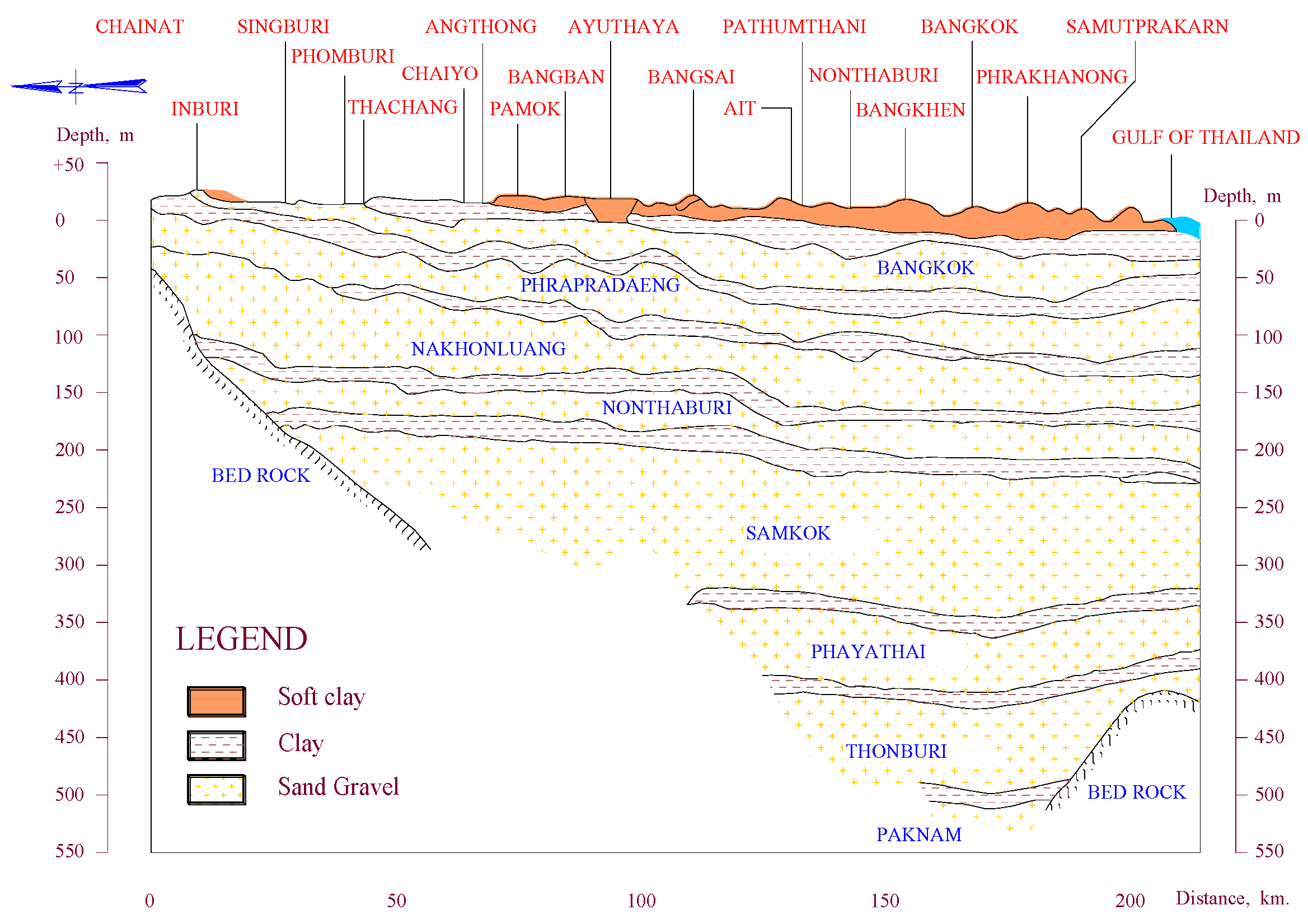
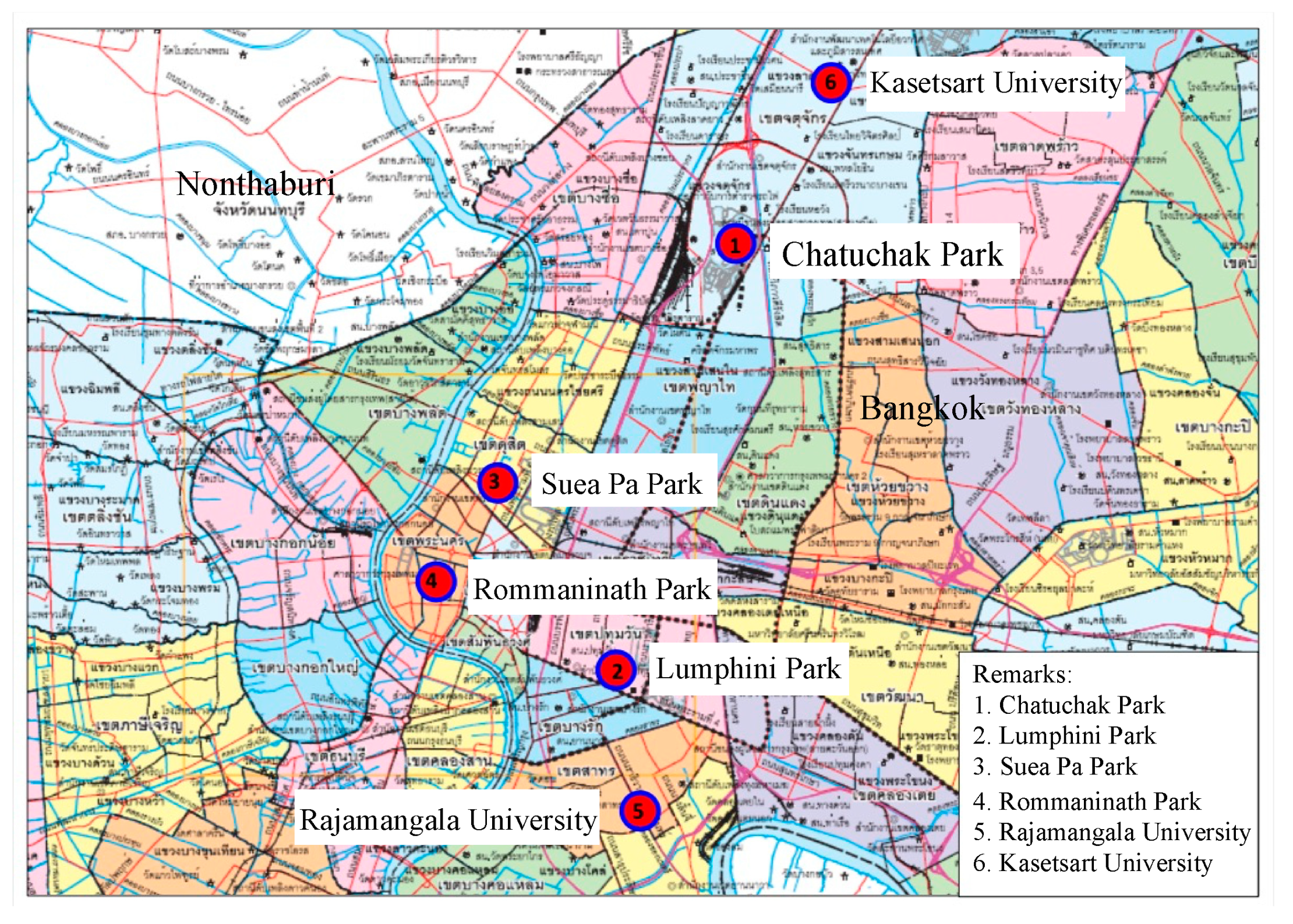


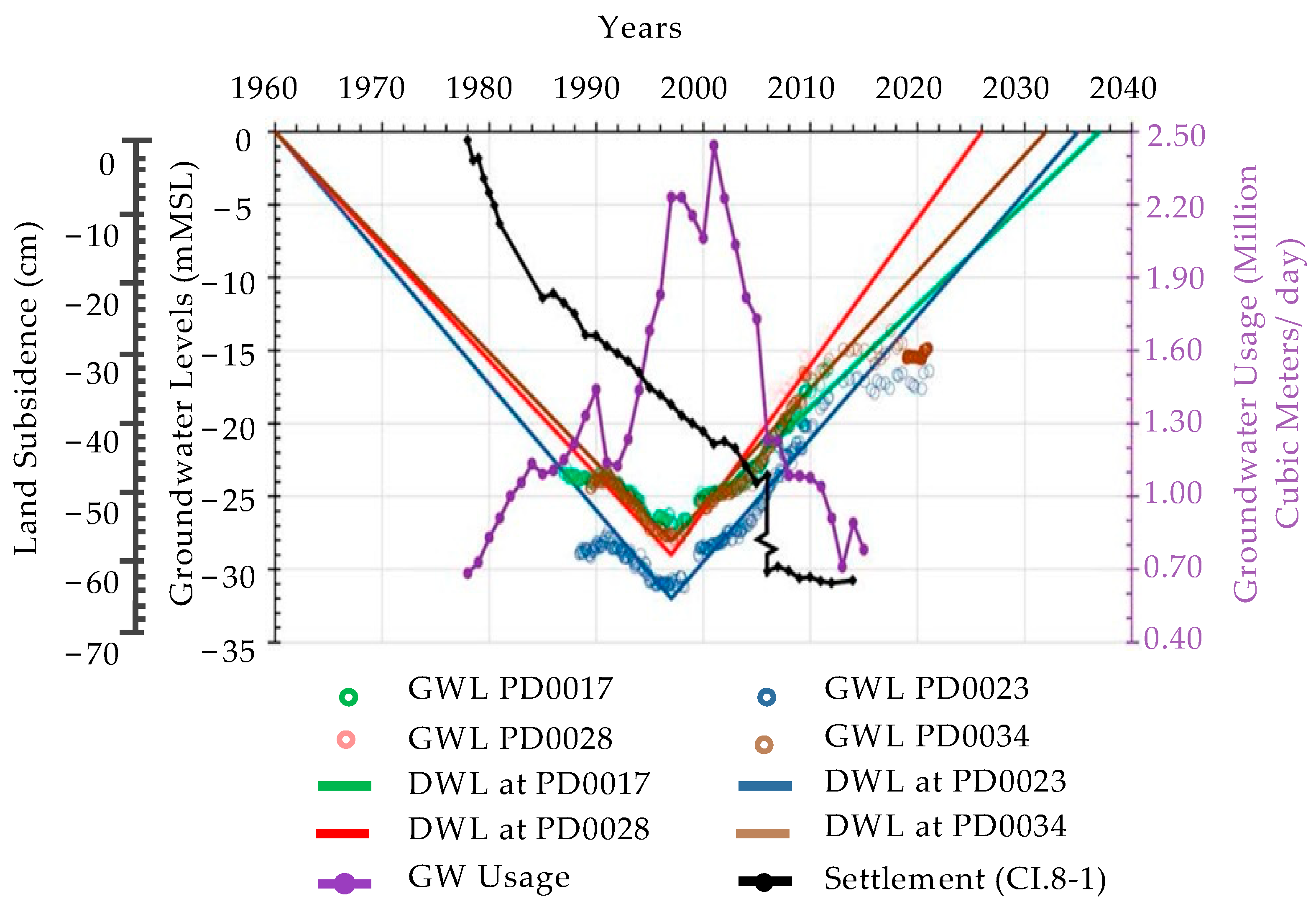
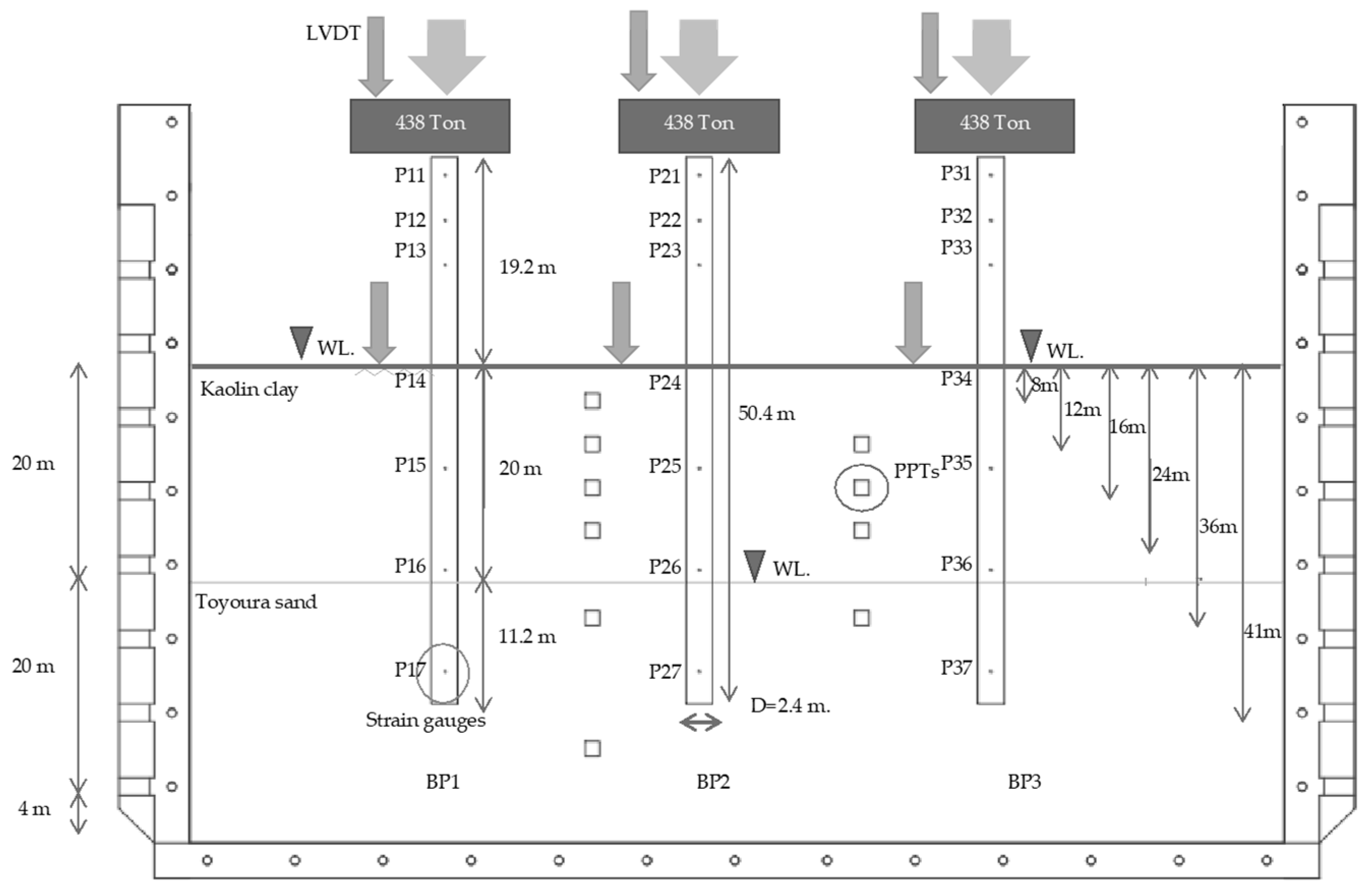
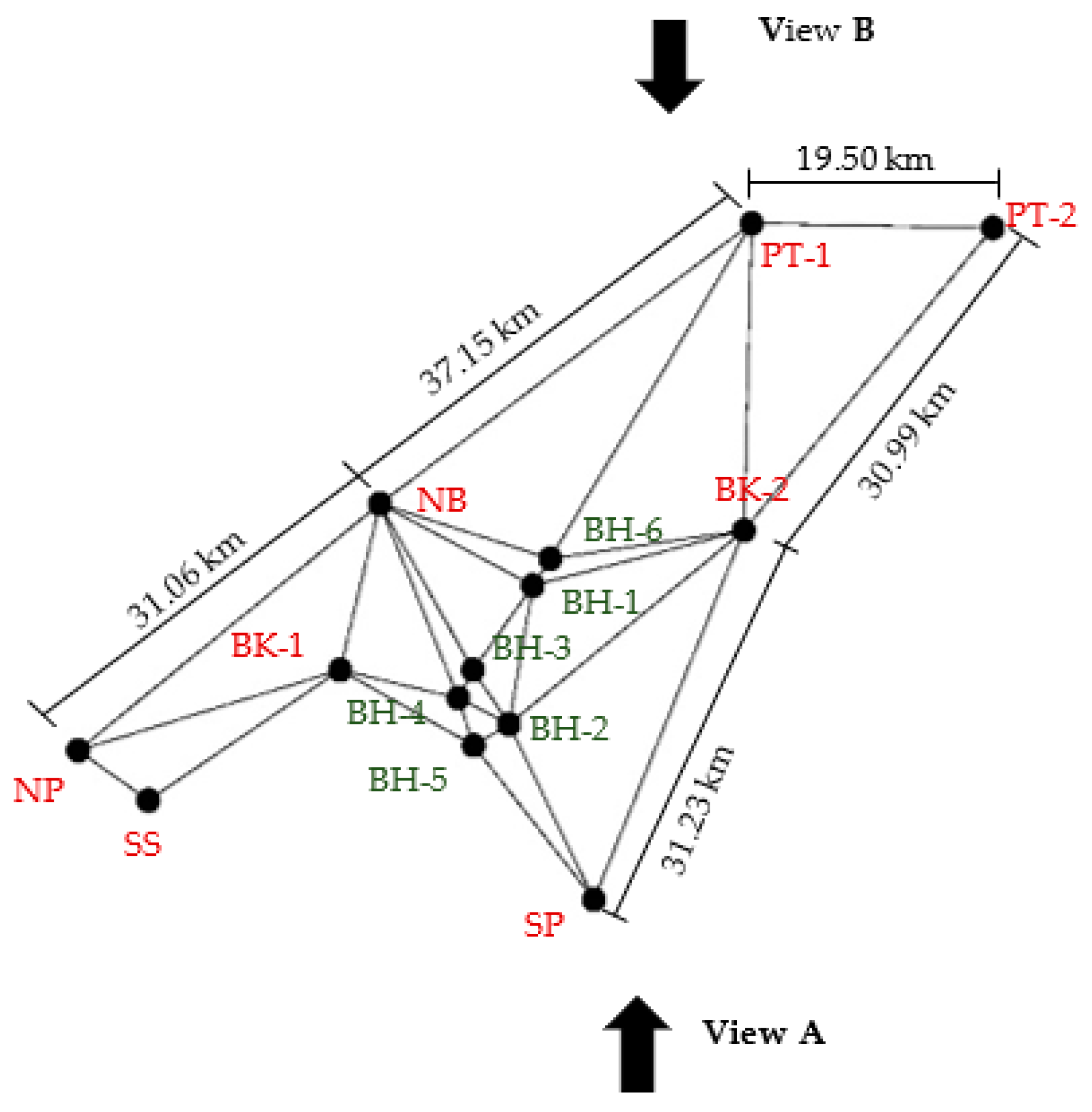
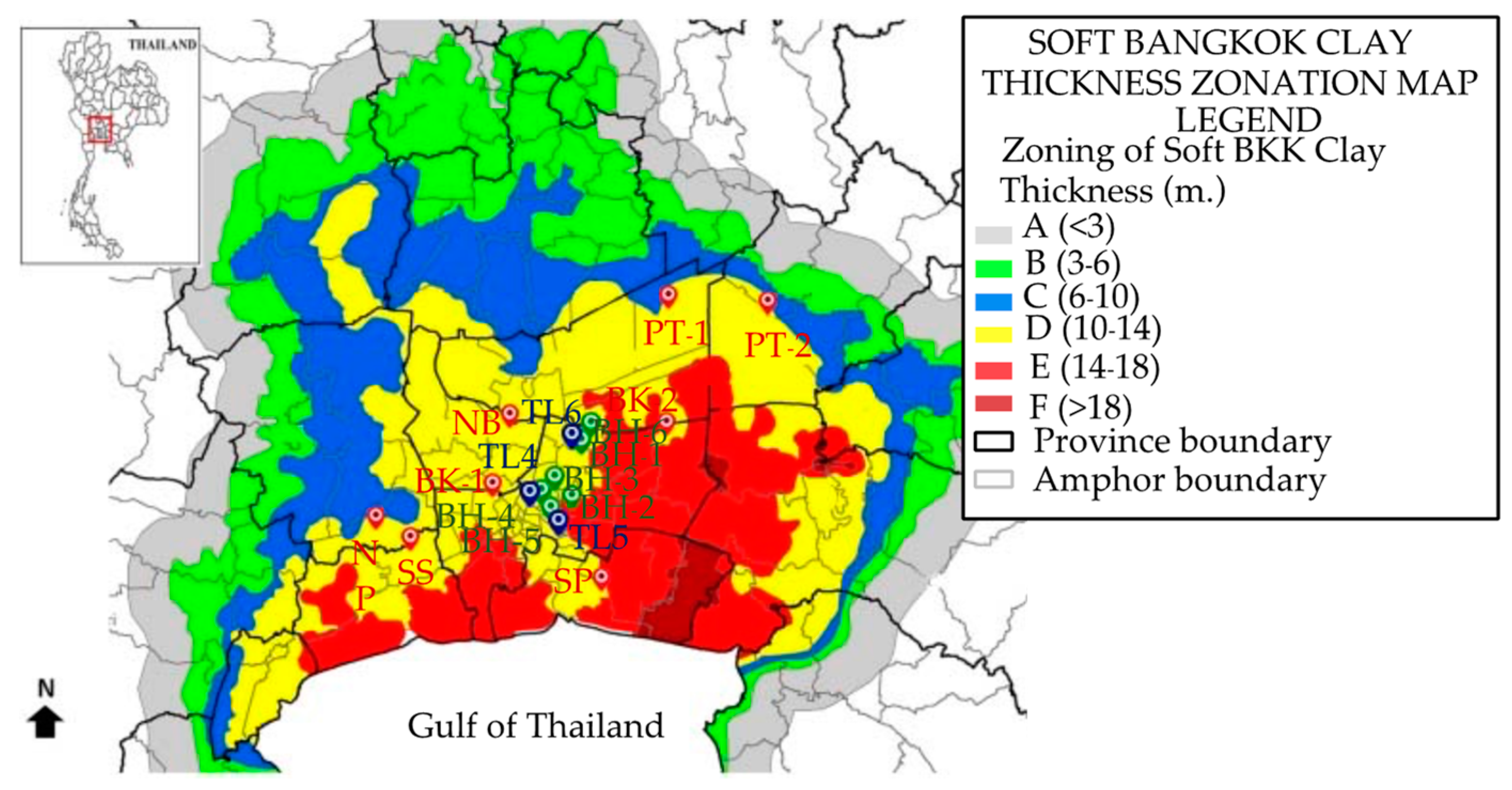


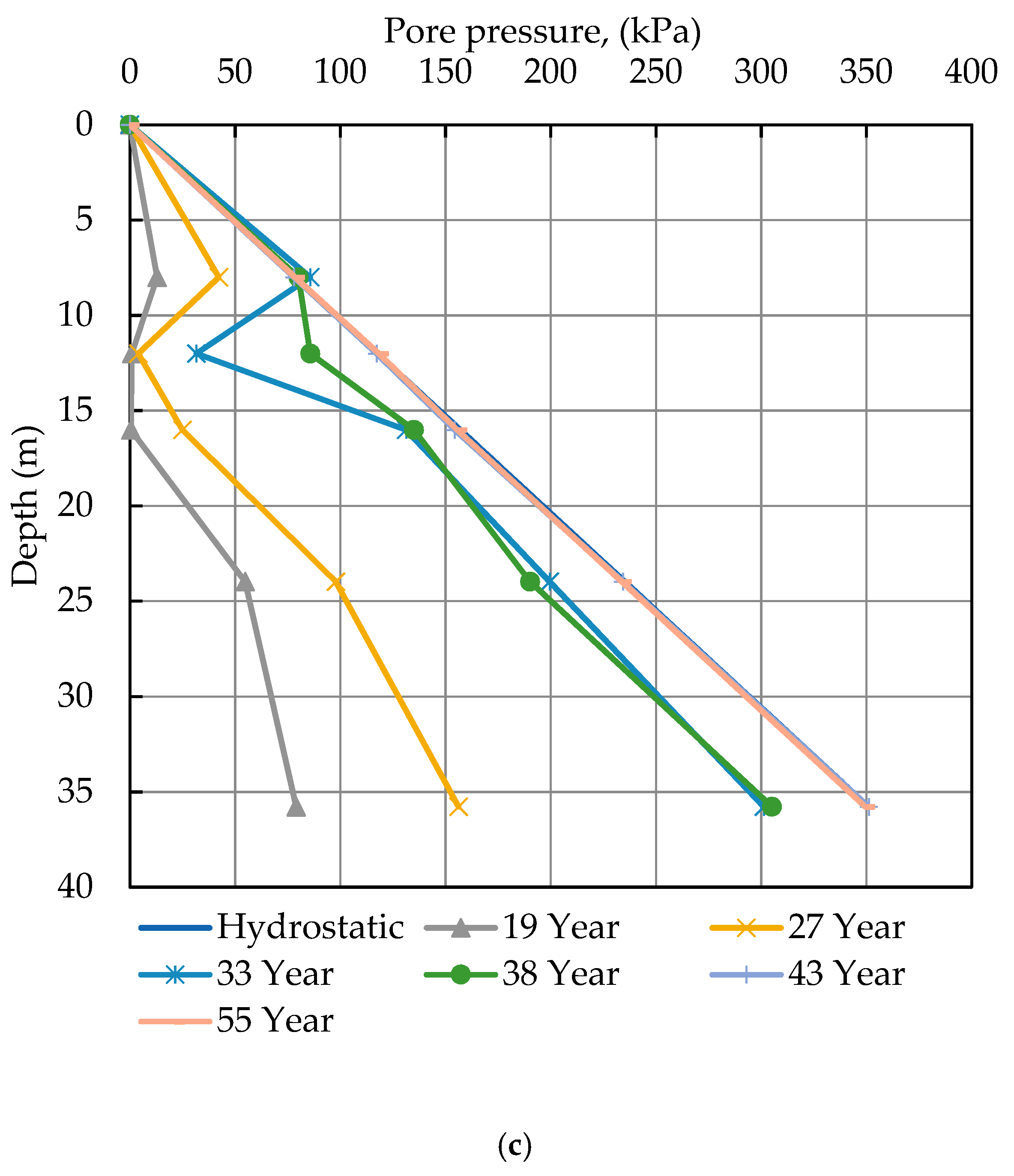
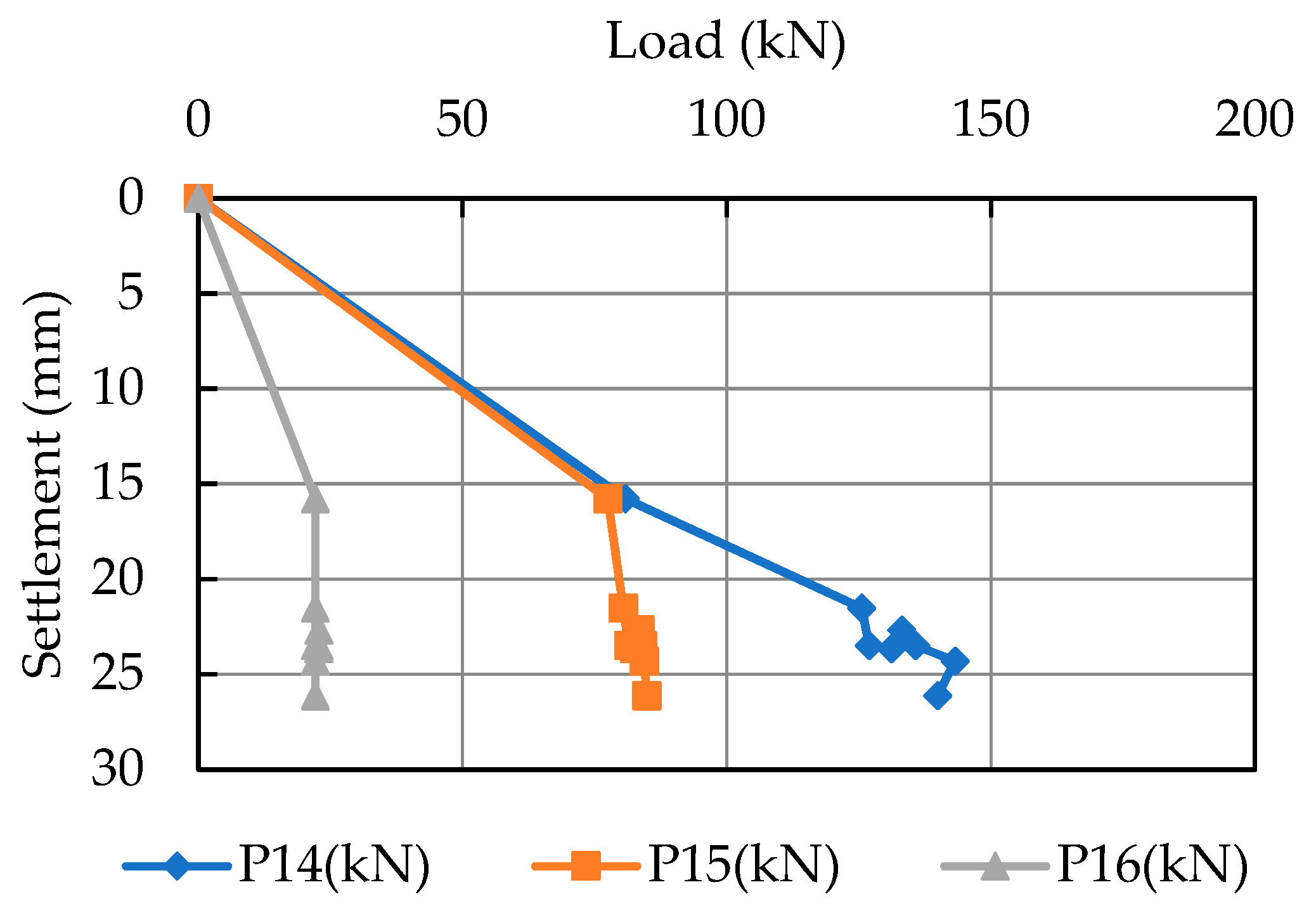
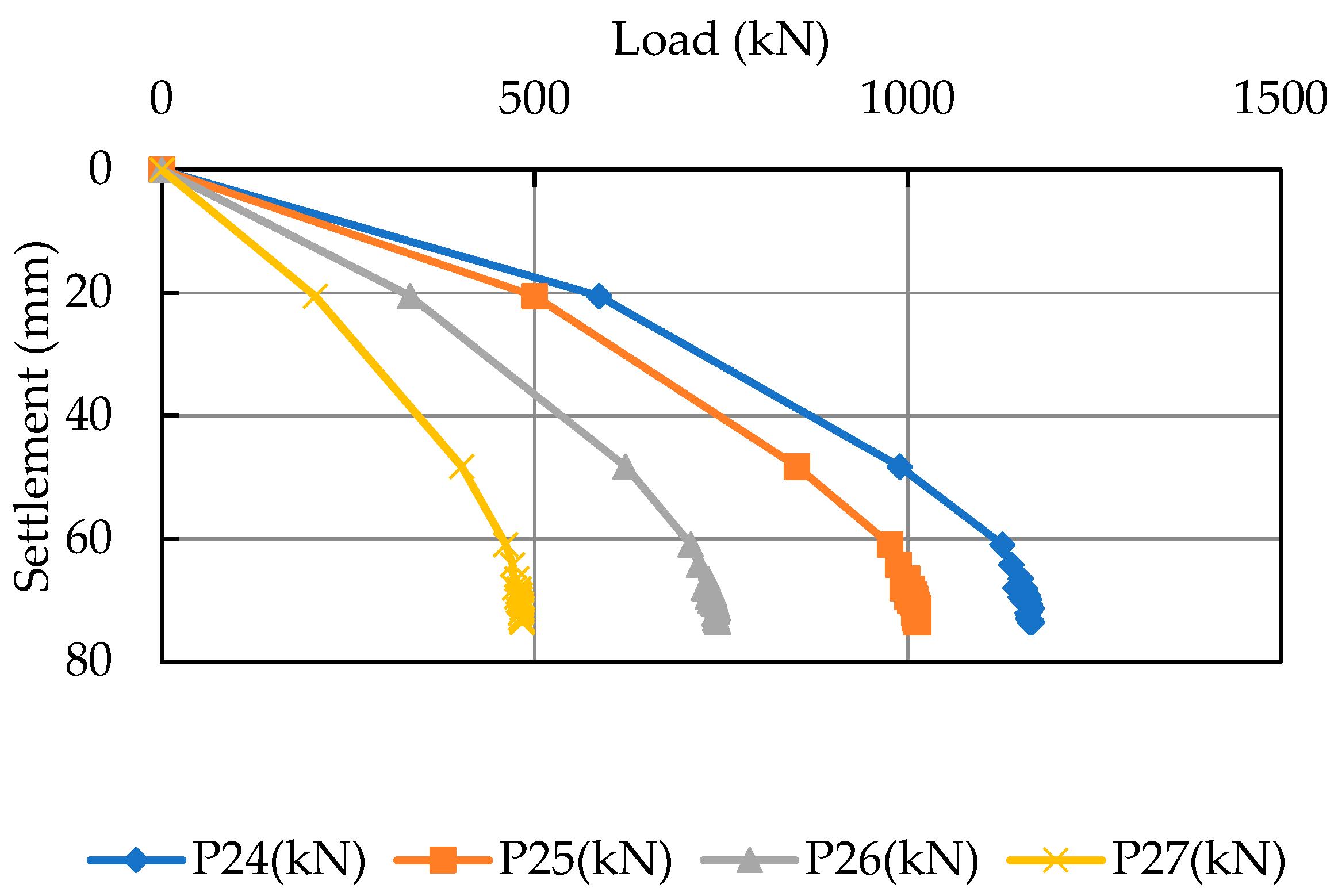
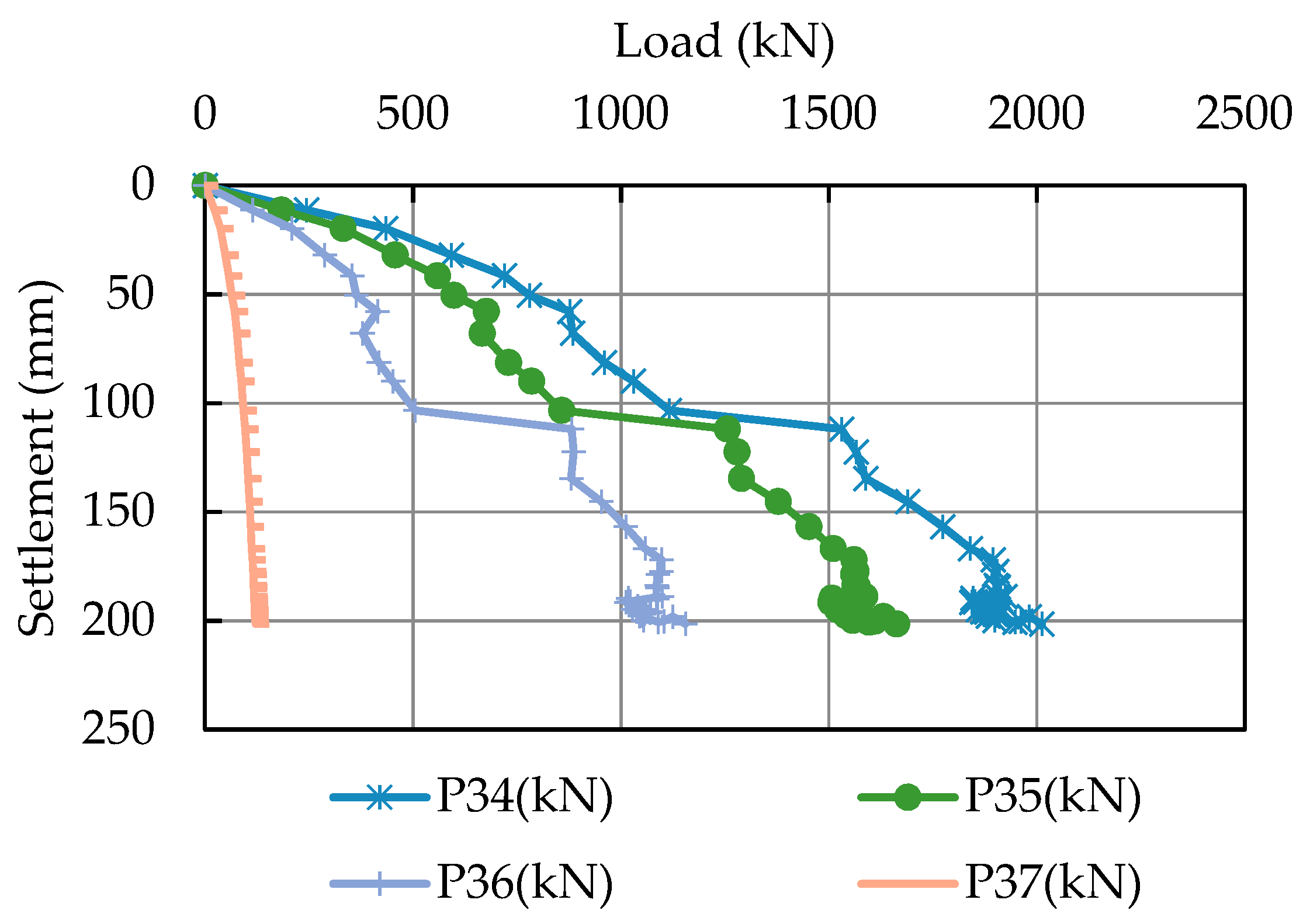
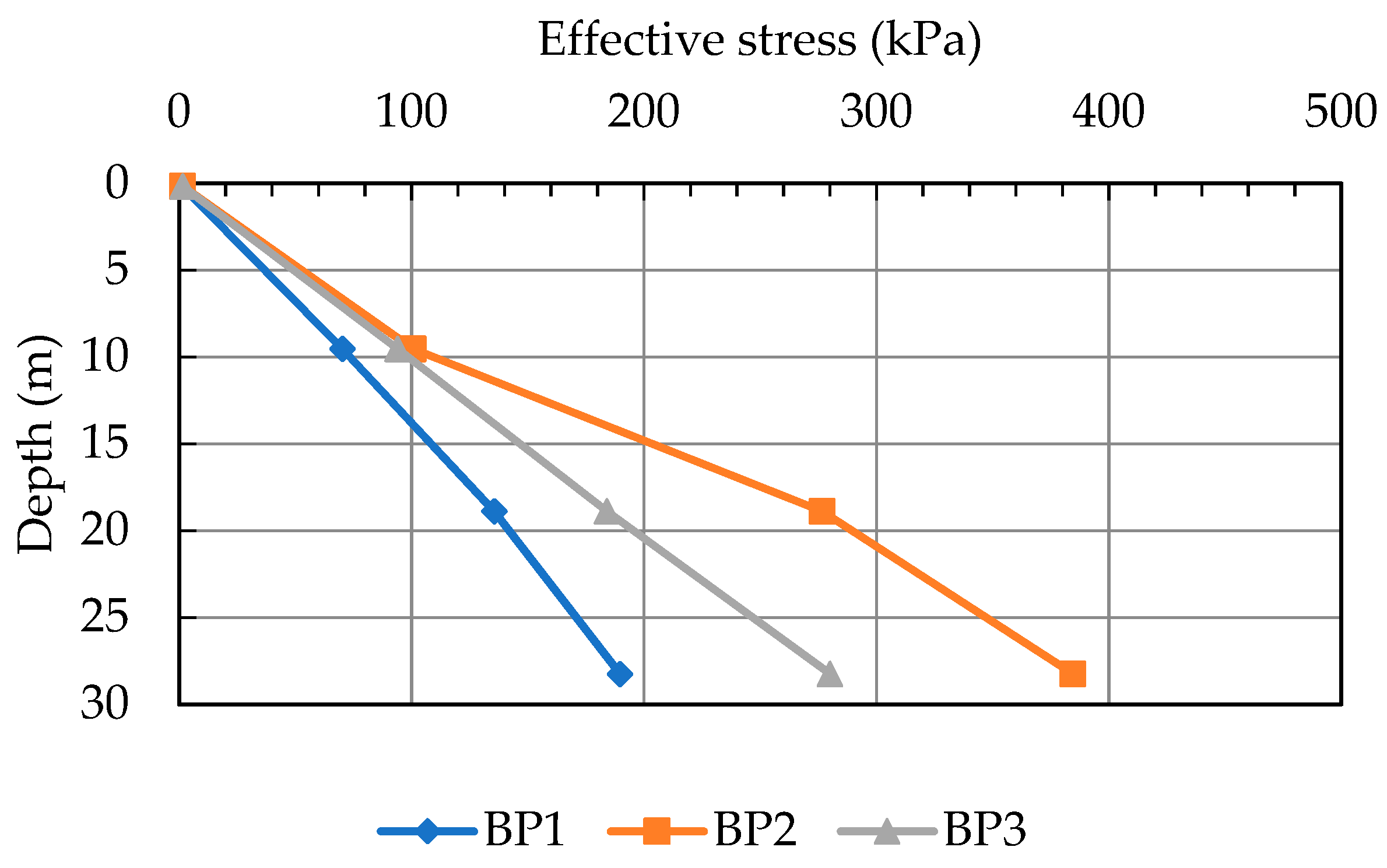


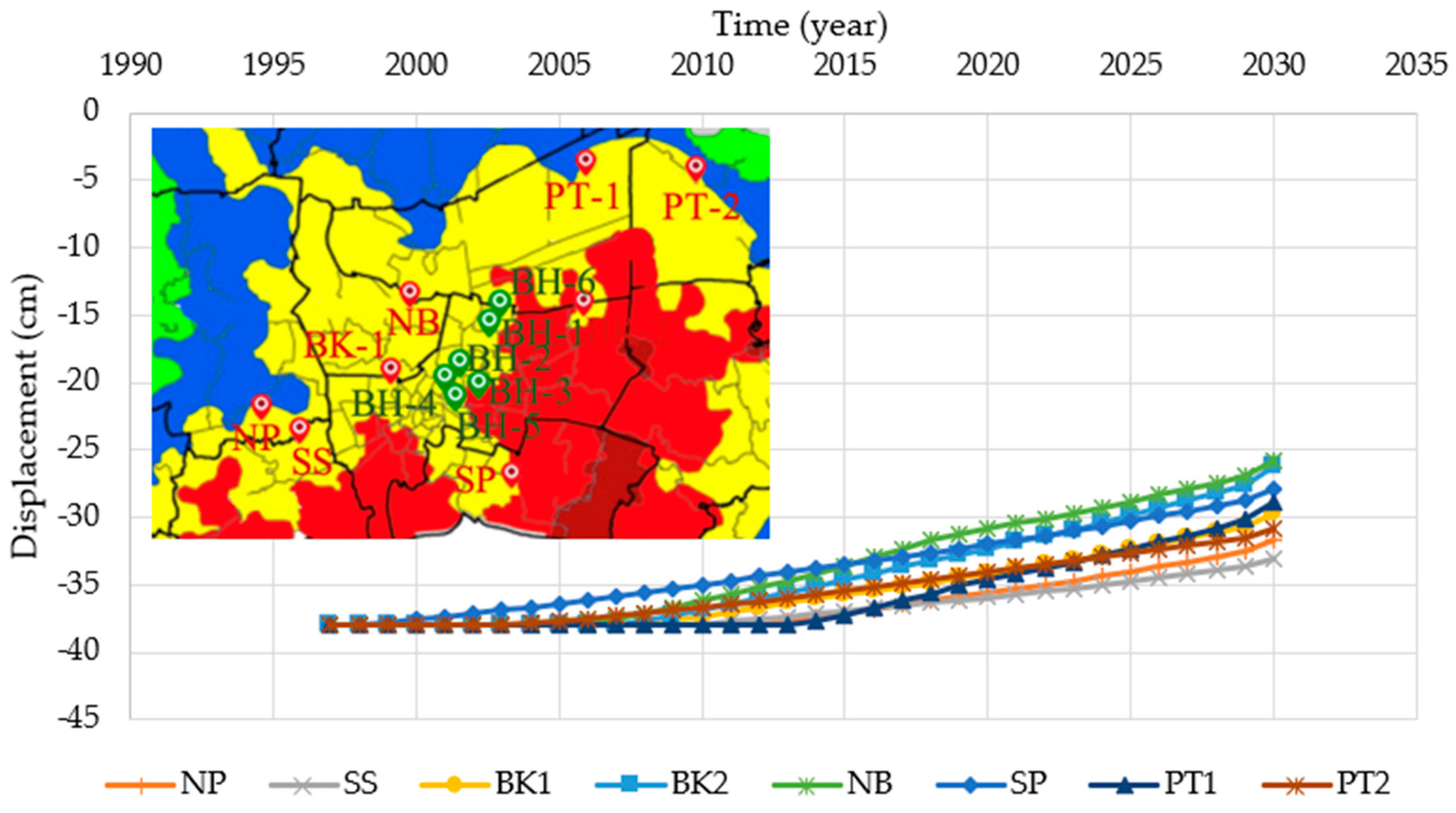
| Location | Name | Symbol |
|---|---|---|
| 1 | Chatuchak Park | BH−1 |
| 2 | Lumphini Park | BH−2 |
| 3 | Suea Pa Park | BH−3 |
| 4 | Rommaninath Park | BH−4 |
| 5 | Rajamangala University | BH−5 |
| 6 | Kasetsart University | BH−6 |
| Name of Stain Gauge | Distance of Strain Gauge from Ground Surface (m) | ||
|---|---|---|---|
| 1st Test Stage | 2nd Test Stage | 3rd Test Stage | |
| P14 | P24 | P34 | 0.16 |
| P15 | P25 | P35 | 9.52 |
| P16 | P26 | P36 | 18.89 |
| P17 | P27 | P37 | 28.25 |
| Bored Hole | Total Soil Surface Displacement (cm) | Rebound Displacement Rate (cm/year) | |
|---|---|---|---|
| In 1997 | In 2030 | ||
| NP | −10.70 | −17.03 | 0.19 |
| SS | −8.36 | −13.28 | 0.14 |
| BK-1 | −13.98 | −22.24 | 0.24 |
| BK-2 | −19.81 | −31.54 | 0.35 |
| NB | −20.84 | −33.02 | 0.36 |
| SP | −17.14 | −27.20 | 0.30 |
| PT-1 | −15.29 | −24.39 | 0.27 |
| PT-2 | −12.32 | −19.43 | 0.21 |
| Description/Researchers | Centrifuge Test | Land Subsidence (DGR) | ||||
|---|---|---|---|---|---|---|
| Wat Koowanaram, Bang Pli, Samut Pakarn | Hua Mak, Bang Kapi | CU, Phathum Wan | ||||
| Time Period (year) | 188.73 | 22 (1979–1997) | 6 (1979–1985) | 13 (1985–1998) | 19 (1978–1997) | 10 (1997–2007) |
| Displacement rate (cm/year) | 2.12 | 2.42 | 9.72 | 2.15 | 2 | 1.1 |
| Description/Researchers | Centrifuge Test | DGR | |
|---|---|---|---|
| Hua Mak, Bang Kapi | CU, Phathum Wan | ||
| Period time (year) | 53 | 8 (1998–2007) | 5 (2007–2012) |
| Displacement rate (cm/year) | 0.37 | 1.3 | 0.4 |
Publisher’s Note: MDPI stays neutral with regard to jurisdictional claims in published maps and institutional affiliations. |
© 2022 by the authors. Licensee MDPI, Basel, Switzerland. This article is an open access article distributed under the terms and conditions of the Creative Commons Attribution (CC BY) license (https://creativecommons.org/licenses/by/4.0/).
Share and Cite
Intui, S.; Inazumi, S.; Soralump, S. Sustainability of Soil/Ground Environment under Changes in Groundwater Level in Bangkok Plain, Thailand. Sustainability 2022, 14, 10908. https://doi.org/10.3390/su141710908
Intui S, Inazumi S, Soralump S. Sustainability of Soil/Ground Environment under Changes in Groundwater Level in Bangkok Plain, Thailand. Sustainability. 2022; 14(17):10908. https://doi.org/10.3390/su141710908
Chicago/Turabian StyleIntui, Sutasinee, Shinya Inazumi, and Suttisak Soralump. 2022. "Sustainability of Soil/Ground Environment under Changes in Groundwater Level in Bangkok Plain, Thailand" Sustainability 14, no. 17: 10908. https://doi.org/10.3390/su141710908






